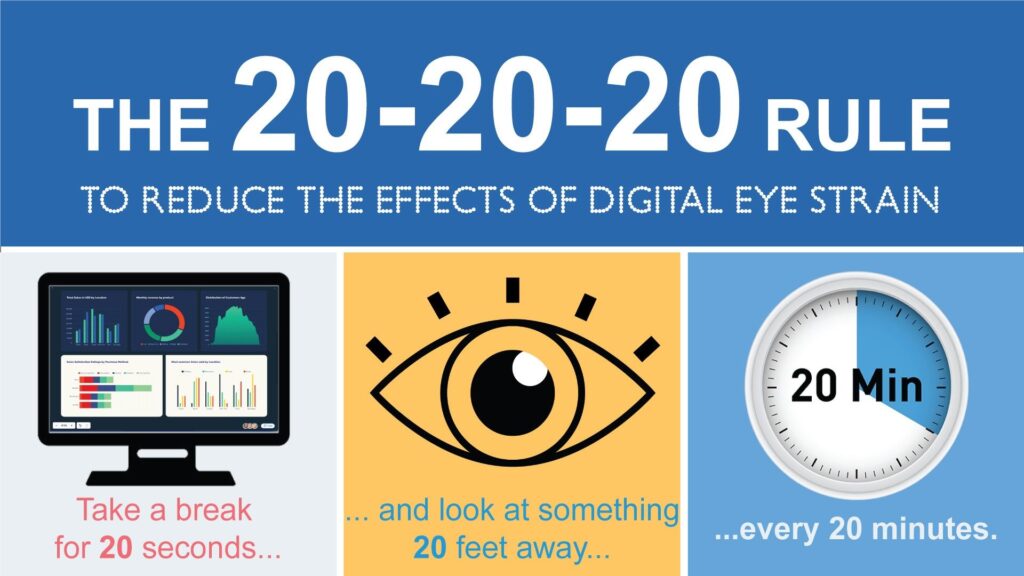In today’s digital age, our lives are increasingly intertwined with screens. Whether it’s working on a computer, scrolling through social media on a smartphone, or binge-watching our favorite shows on a tablet, we spend a significant portion of our day staring at screens. While these devices have undoubtedly made our lives more convenient and entertaining, they’ve also given rise to a new health concern – digital eye strain.
Digital eye strain, also known as computer vision syndrome, is a condition that affects individuals who spend prolonged periods of time looking at digital screens. It can lead to discomfort and a range of symptoms that can interfere with daily life. In this blog post, we’ll delve deeper into digital eye strain, exploring its causes, symptoms, and most importantly, how to prevent it.
Causes of Digital Eye Strain
Digital eye strain is a result of extended screen time and the specific characteristics of digital screens. Several factors contribute to its onset.
Blue Light Emission: Digital screens emit a high amount of blue light, which has shorter wavelengths and higher energy compared to other visible light. Excessive exposure to blue light can disrupt your sleep-wake cycle and strain your eyes.
Close-up Focus: When using digital devices, we tend to hold them closer to our eyes than printed materials. This forces our eye muscles to work harder to maintain focus, leading to fatigue.
Screen Glare and Reflections: Poor lighting conditions and screen glare from nearby windows or bright light sources can cause reflections and make it harder to see, increasing eye strain.
Blink Rate: When looking at screens, people tend to blink less frequently, reducing the moisture on the surface of the eyes. This can lead to dry eyes and discomfort.
Ergonomics: Poor ergonomic setups, such as improper monitor height or keyboard placement, can contribute to neck, shoulder, and back strain, which in turn affects your eyesight.
Symptoms of Digital Eye Strain
Digital eye strain can manifest in various ways, and its symptoms can range from mild to severe. Here are some common symptoms to watch out for:
Eye Discomfort: This can include dryness, redness, burning, or a gritty feeling in the eyes.
Blurred Vision: Vision can become blurry, especially after prolonged screen exposure.
Headaches: Frequent or persistent headaches, often centered around the temples or forehead, can be a sign of digital eye strain.
Neck and Shoulder Pain: Poor posture and extended screen time can lead to muscle tension in the neck and shoulders.
Difficulty Focusing: You may experience difficulty changing focus between the screen and objects in the distance.
Increased Sensitivity to Light: Bright lights may become more bothersome than usual.
Watery Eyes: Paradoxically, your eyes may water as they try to combat dryness.
Double Vision: Seeing double or overlapping images, especially when tired.
Preventing Digital Eye Strain
The good news is that digital eye strain is preventable. Implementing a few simple strategies can help alleviate and even prevent the discomfort associated with prolonged screen time.

Follow the 20-20-20 Rule: Every 20 minutes, take a 20-second break and look at something 20 feet away. This exercise helps relax the eye muscles and reduces strain.
Optimize Screen Settings: Adjust the brightness, contrast, and font size on your screen to make reading more comfortable. Use blue light filters or wear blue light-blocking glasses to reduce blue light exposure.
Proper Lighting: Ensure your workspace is well-lit to reduce screen glare and reflections. Avoid working in overly bright or dim environments.
Ergonomic Setup: Maintain good posture and arrange your workstation ergonomically. Your computer monitor should be at eye level, and your keyboard and mouse should be at a comfortable height.
Blink Regularly: Make a conscious effort to blink frequently to keep your eyes moist. Consider using artificial tears if needed.
Regular Eye Exams: Schedule routine eye exams to monitor your eye health and discuss any concerns with your eye care professional.
Digital Detox: Take breaks from digital devices whenever possible. Engage in outdoor activities or hobbies that don’t require screen time.
Stay Hydrated: Drink plenty of water to keep your body and eyes hydrated.
Adjust Screen Time: Limit screen time, especially before bedtime, to ensure a good night’s sleep.
Blue Light Filters: Use software or apps that reduce blue light emissions from your screens during nighttime hours.
Conclusion
Digital eye strain is a growing concern in our screen-dominated world. It can affect anyone who spends significant time in front of digital devices, from children doing online classes to professionals working long hours on computers. However, by understanding its causes, recognizing the symptoms, and adopting preventive measures, we can reduce the impact of digital eye strain on our daily lives. Prioritizing our eye health is essential in our digital age, and with these strategies, we can ensure our eyes remain comfortable and healthy as we navigate the digital landscape.
Author: Vision Plus Eye Centre is a super-specialty eye hospital led by Dr. Ajay and Ritu Aurora, offering advanced technologies, world-class facilities, affordable rates, and a caring team. Guided by expert surgeons and seasoned eye specialists in Noida, the clinic provides an extensive range of eye care services, with a particular focus on addressing retinal conditions.